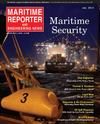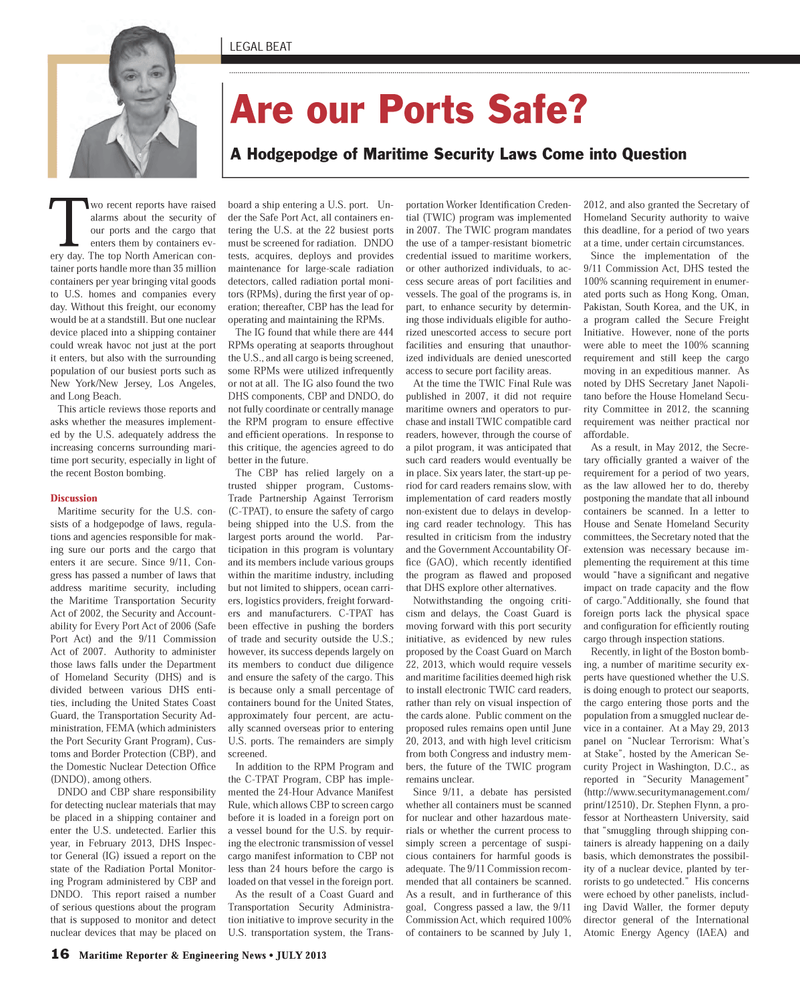
Page 16: of Maritime Reporter Magazine (July 2013)
Maritime Security Edition
Read this page in Pdf, Flash or Html5 edition of July 2013 Maritime Reporter Magazine
16 Maritime Reporter & Engineering News ? JULY 2013 LEGAL BEAT Are our Ports Safe? A Hodgepodge of Maritime Security Laws Come into QuestionTwo recent reports have raised alarms about the security of our ports and the cargo that enters them by containers ev-ery day. The top North American con- tainer ports handle more than 35 million containers per year bringing vital goods to U.S. homes and companies every day. Without this freight, our economy would be at a standstill. But one nuclear device placed into a shipping container could wreak havoc not just at the port it enters, but also with the surrounding population of our busiest ports such as New York/New Jersey, Los Angeles, and Long Beach. This article reviews those reports and asks whether the measures implement-ed by the U.S. adequately address the increasing concerns surrounding mari-time port security, especially in light of the recent Boston bombing.DiscussionMaritime security for the U.S. con-sists of a hodgepodge of laws, regula-tions and agencies responsible for mak-ing sure our ports and the cargo that enters it are secure. Since 9/11, Con- gress has passed a number of laws that address maritime security, including the Maritime Transportation Security Act of 2002, the Security and Account- ability for Every Port Act of 2006 (Safe Port Act) and the 9/11 Commission Act of 2007. Authority to administer those laws falls under the Department of Homeland Security (DHS) and is divided between various DHS enti-ties, including the United States Coast Guard, the Transportation Security Ad- ministration, FEMA (which administers the Port Security Grant Program), Cus-toms and Border Protection (CBP), and the Domestic Nuclear Detection OfÞ ce (DNDO), among others.DNDO and CBP share responsibility for detecting nuclear materials that may be placed in a shipping container and enter the U.S. undetected. Earlier this year, in February 2013, DHS Inspec- tor General (IG) issued a report on the state of the Radiation Portal Monitor- ing Program administered by CBP and DNDO. This report raised a number of serious questions about the program that is supposed to monitor and detect nuclear devices that may be placed on board a ship entering a U.S. port. Un-der the Safe Port Act, all containers en- tering the U.S. at the 22 busiest ports must be screened for radiation. DNDO tests, acquires, deploys and provides maintenance for large-scale radiation detectors, called radiation portal moni-tors (RPMs), during the Þ rst year of op- eration; thereafter, CBP has the lead for operating and maintaining the RPMs. The IG found that while there are 444 RPMs operating at seaports throughout the U.S., and all cargo is being screened, some RPMs were utilized infrequently or not at all. The IG also found the two DHS components, CBP and DNDO, do not fully coordinate or centrally manage the RPM program to ensure effective and efÞ cient operations. In response to this critique, the agencies agreed to do better in the future. The CBP has relied largely on a trusted shipper program, Customs-Trade Partnership Against Terrorism (C-TPAT), to ensure the safety of cargo being shipped into the U.S. from the largest ports around the world. Par- ticipation in this program is voluntary and its members include various groups within the maritime industry, including but not limited to shippers, ocean carri-ers, logistics providers, freight forward-ers and manufacturers. C-TPAT has been effective in pushing the borders of trade and security outside the U.S.; however, its success depends largely on its members to conduct due diligence and ensure the safety of the cargo. This is because only a small percentage of containers bound for the United States, approximately four percent, are actu-ally scanned overseas prior to entering U.S. ports. The remainders are simply screened.In addition to the RPM Program and the C-TPAT Program, CBP has imple- mented the 24-Hour Advance Manifest Rule, which allows CBP to screen cargo before it is loaded in a foreign port on a vessel bound for the U.S. by requir- ing the electronic transmission of vessel cargo manifest information to CBP not less than 24 hours before the cargo is loaded on that vessel in the foreign port. As the result of a Coast Guard and Transportation Security Administra- tion initiative to improve security in the U.S. transportation system, the Trans- portation Worker Identi Þ cation Creden- tial (TWIC) program was implemented in 2007. The TWIC program mandates the use of a tamper-resistant biometric credential issued to maritime workers, or other authorized individuals, to ac-cess secure areas of port facilities and vessels. The goal of the programs is, in part, to enhance security by determin-ing those individuals eligible for autho-rized unescorted access to secure port facilities and ensuring that unauthor- ized individuals are denied unescorted access to secure port facility areas. At the time the TWIC Final Rule was published in 2007, it did not require maritime owners and operators to pur- chase and install TWIC compatible card readers, however, through the course of a pilot program, it was anticipated that such card readers would eventually be in place. Six years later, the start-up pe- riod for card readers remains slow, with implementation of card readers mostly non-existent due to delays in develop-ing card reader technology. This has resulted in criticism from the industry and the Government Accountability Of- Þ ce (GAO), which recently identi Þ ed the program as ß awed and proposed that DHS explore other alternatives. Notwithstanding the ongoing criti-cism and delays, the Coast Guard is moving forward with this port security initiative, as evidenced by new rules proposed by the Coast Guard on March 22, 2013, which would require vessels and maritime facilities deemed high risk to install electronic TWIC card readers, rather than rely on visual inspection of the cards alone. Public comment on the proposed rules remains open until June 20, 2013, and with high level criticism from both Congress and industry mem-bers, the future of the TWIC program remains unclear. Since 9/11, a debate has persisted whether all containers must be scanned for nuclear and other hazardous mate-rials or whether the current process to simply screen a percentage of suspi-cious containers for harmful goods is adequate. The 9/11 Commission recom- mended that all containers be scanned. As a result, and in furtherance of this goal, Congress passed a law, the 9/11 Commission Act, which required 100% of containers to be scanned by July 1, 2012, and also granted the Secretary of Homeland Security authority to waive this deadline, for a period of two years at a time, under certain circumstances. Since the implementation of the 9/11 Commission Act, DHS tested the 100% scanning requirement in enumer- ated ports such as Hong Kong, Oman, Pakistan, South Korea, and the UK, in a program called the Secure Freight Initiative. However, none of the ports were able to meet the 100% scanning requirement and still keep the cargo moving in an expeditious manner. As noted by DHS Secretary Janet Napoli-tano before the House Homeland Secu-rity Committee in 2012, the scanning requirement was neither practical nor affordable. As a result, in May 2012, the Secre-tary ofÞ cially granted a waiver of the requirement for a period of two years, as the law allowed her to do, thereby postponing the mandate that all inbound containers be scanned. In a letter to House and Senate Homeland Security committees, the Secretary noted that the extension was necessary because im-plementing the requirement at this time would ?have a signiÞ cant and negative impact on trade capacity and the ß ow of cargo.?Additionally, she found that foreign ports lack the physical space and conÞ guration for ef Þ ciently routing cargo through inspection stations. Recently, in light of the Boston bomb- ing, a number of maritime security ex-perts have questioned whether the U.S. is doing enough to protect our seaports, the cargo entering those ports and the population from a smuggled nuclear de-vice in a container. At a May 29, 2013 panel on ?Nuclear Terrorism: What?s at Stake?, hosted by the American Se- curity Project in Washington, D.C., as reported in ?Security Management? (http://www.securitymanagement.com/ print/12510), Dr. Stephen Flynn, a pro- fessor at Northeastern University, said that ?smuggling through shipping con-tainers is already happening on a daily basis, which demonstrates the possibil-ity of a nuclear device, planted by ter- rorists to go undetected.? His concerns were echoed by other panelists, includ-ing David Waller, the former deputy director general of the International Atomic Energy Agency (IAEA) and MR #7 (10-17).indd 16MR #7 (10-17).indd 167/1/2013 8:54:57 AM7/1/2013 8:54:57 AM

 15
15

 17
17
